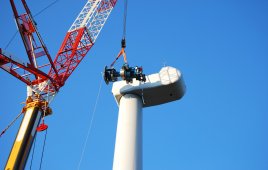A gear manufacturer recently confided that a turbine OEM was asking for quotes to repair yaw gears that were failing after just five years in service. Although the mystery of the early failure has not yet been resolved, the tale says that despite centuries of experience with gear designs and materials, turbines have a lot to say. One way to keep an ear on the rotating machinery high in a nacelle is by monitoring vibration at critical locations. This is done by fixing accelerometers to gearbox casings. Readouts from such sensors are in the time domain so their graphs show acceleration (in G’s) versus time. But a fast Fourier transform (FFT) performed by software can translate it into the frequency domain to show what defect frequencies are occurring. That information tells what’s going on inside a gearbox.
“These innovations are not yet good enough to pinpointing an exact failure date because of variability and loading,” says Bill Stan, president of Horsburgh and Scott NDT, Cleveland, Ohio. (horsburghandscott.com). Still, says the condition monitoring expert, the data collected from an accelerometer and FFT can point to the four classic phases of antifriction-bearing failure that tell the severity of a bearing defect or the condition of the gear teeth which again provides severity of gear problems. For example in regard to bearing defects, says Stan:
• Phase one defects typically have elevated vibration in the high frequency range
• Phase two defects are illustrated by elevated vibration at the natural frequencies of the bearing components
• Phase three shows a dominant bearing defect peaks at the defect frequencies and their harmonics, and possibly impacting might be visible on the vibration waveform.
• Phase four, the whole vibration floor of the FFT rises. The defect coefficient actually disappears because the magnitude of the broad band vibration envelops them.

Vibration trend graphs can be generated using peaks or sum of vibration energy either across the spectrum or an individual band.
“So by understanding what phase the gear or bearing is in and looking at a trend screen, maintenance people will get a valuable understanding of how long a component will last and more importantly, whether or not corrective action can be taken to minimize the mechanical stressing. Maintenance managers can then see which of the turbines has the highest and most critical vibration thus establishing which units need maintenance first.
Of the two characteristics monitored most often – vibration and temperature –vibration provides much better insight into the condition of a particular component and much earlier defect detection. Collecting vibration data allows its transformation into a spectrum using FFT. The next step is to take the defect coefficients provided by all bearing manufactures and multiply these by the shaft speed. This calculation provides discrete frequencies on the spectrum that can be monitored by the vibration monitoring software. The same holds true for gear frequencies which are the product of the number of gear teeth times shaft speed.
State-of-the-art condition monitoring systems use software that can narrow band the spectrum or cut the spectrum into multiple bands each of which contains defect frequencies. These bands have individual alarms and reports. With these, high-vibration alarms provide more that just an overall alarm. They can pinpoint a root cause for an alarm and its severity.
A spectrum analysis lets a sensor mounted to a bearing, collect and monitor gear-mesh frequencies and shaft misalignment in addition to bearing conditions because all vibrations are present on the gearbox surface where the sensor is mounted.

In this example data, each band, a frequency of interest, has a different high and low level alarm threshold depending on tolerences established during testing.
At one time, high equipment costs gave owners pause over adding options to their equipment. “That attitude could change with the drop in hardware costs. Conversations with operators and vendors tell me there is a definite disparity between state-of-the-art condition monitoring equipment and what is in use. I think part of that disparity is based on initial cost estimates owners got for installing equipment from some vendors, so high it was shocking. Today, monitoring equipment is PC based and works with the XP operating system, and reliable software provides an efficient operating platform that gives a software engineer more flexibility in designing a stable and reliable program suitable for condition monitoring.
Stan says refitting a gearbox with condition monitoring sensors is not difficult because the accelerometers attach to the outside near the bearing or gear of interest. Sensors mount magnetically or with adhesives. There is no drilling as was necessary for proximity probes used in other industries to monitor eddy currents. They still have their place in vibration monitoring, primarily for journal bearings on ground-based equipment. In the past, vibration sensors were relatively expensive. But the use of ceramic crystals in piezoelectric accelerometers has significantly brought their cost down. It is important to note that a successful application depends on selecting the right sensor, and wiring that minimizes noise.
Even in that late 90s, people were still quoting $30,000 Dec Alpha boxes to crunch the numbers. “It was the only thing with sufficient computational speed, and guys like me wanted to bring data from every accelerometer into a computer to do an FFT conversion to see the frequency domain,” says Stan. The net result is that as the computational speed of computers has increased along with storage, their price has come way down making it possible to combine low-cost sensors and computers with reliable software in monitoring equipment that was just not available until recently.
Wind farms will not be able to sustain many unplanned shutdowns if they are to be considered economic alternatives to other energy producers. They will have to be more durable. Condition monitoring can help make wind turbines more reliable and cost effective in the same way they have been used in chemical plants, steel mills, and mining because the physics behind vibration base condition monitoring transcends all industries and manufacturing.
::Windpower Engineering::
Filed Under: Bearings, Gearboxes, Nacelle




[…] read more at: http://www.windpowerengineering.com […]